(This article was first emailed on June 14th, 2021 to fans who had registered an interest in finding out more about our Tricorder.)
When different lines cross, interesting things happen.
And so it happened that when Wah Chang, the artist, sculptor and master prop maker, crossed paths with Dr. Oster through Edmund Scientific, an army surplus outlet that specialised in supplying lenses and telescope kits, more than just a prop’s dynamic eye-candy resulted: something of huge scientific relevance was built into the Star Trek props.
Chang didn’t need to spend too much time leafing through the 1965 Edmund Scientific catalogue 661 to work out if it had what he needed; the cover told him what he was looking for would be inside – Science, Optics, Math – the catalogue’s byline pretty much describes the tricorder’s functions. From a prop-building perspective, Edmund Scientific was an Aladdin’s cave of useful goodies, but the feature on moiré patterns on page 74 must have jumped out at Chang. Simply sliding those evenly spaced lines over each other quickly creates the most dynamic and mesmerisingly technical patterns of billowing arcs perpetually bubbling out of every edge of the image.
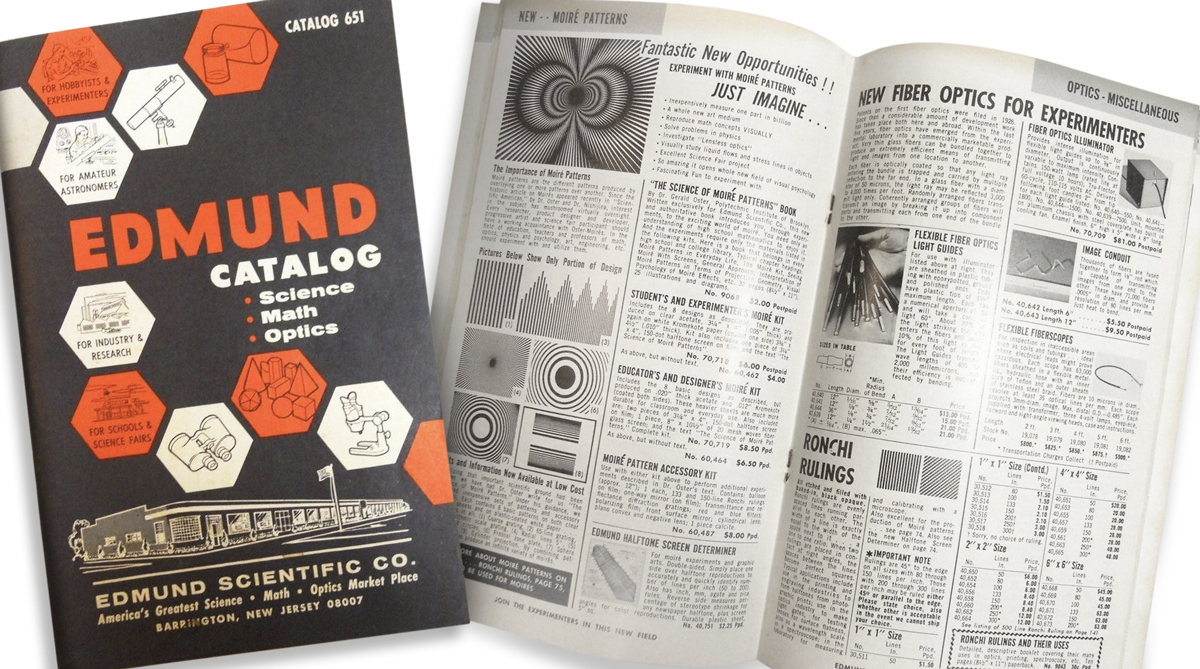
The 1965 Edmund Scientific Catalogue: Science, Math, Optics, it’s a sci-fi prop maker’s dream come true.
When putting our communicator moiré together we had the incredible help of HeroComm, who kindly loaned us an original 1965 “Educator’s and Designer’s Moiré Series (A)-Deluxe Kit”. The amazing resources on the HeroComm website helped us cut the moiré from exactly the right position from Pattern #4, but when it came to the tricorder, we had to work things out for ourselves. In order to replicate the moiré pattern as seen in all the known photos of the hero prop, a close-up of the studio photo from “The Making of Star Trek” book, corrected for perspective, was overdrawn with lines to pinpoint the centre of the pattern.

First square up a crop of the screencap moiré, then draw lines over it to find the pattern centre.
We knew that the moiré pattern was created from two discs cut from the same Edmund Scientific moiré sheet as the comm had been, but had been cut from a different part of the pattern. By overlaying our line drawings on Pattern #4, we were quickly able to see where to take the tricorder’s moiré discs from.
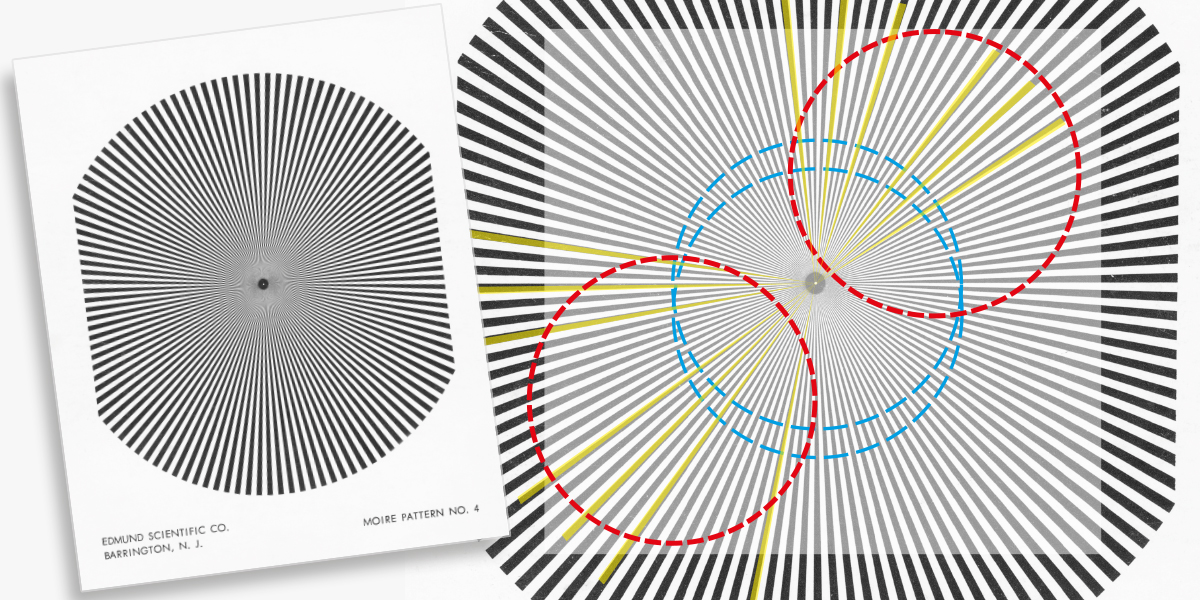
The original moiré was made by superimposing a transparent film of the pattern over a version of the pattern printed on white card. The blue circles show where the communicator’s moiré discs were cut from – the red circles show the position of the tricorder’s discs.
While the tricorder has a moiré disc similar to the communicator, given the lack of space for a communicator-style pocket-watch drive mechanism behind the tricorder prop’s front panel, it is clear that the tricorder’s moiré never actually rotated. Nevertheless, as the static pattern we see in the photographs is clearly made from two discs sitting on top of each other, it was never in question that our tricorder’s moiré should rotate to bring that pattern alive. With the two patterns overlaid and moving, the evolving fringes turn out to be very exciting and do have the look of strange magnetic flux lines, perhaps displaying some otherwise-unseen aspect of a subspace signal.
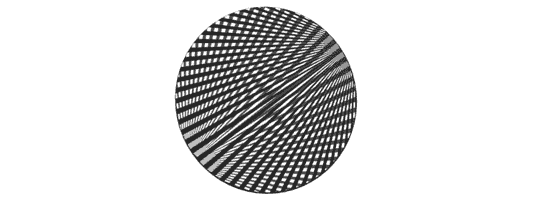
Early animation tests conducted early on in the project showed that the rotating moiré would deliver a fascinating pattern.
The stepper motor we chose to drive the tricorder’s moiré is much larger than the one we used for the communicator. Space inside the communicator is very limited: the moiré driving motor has to sit just under the moiré disc, on top of the speaker. Only the smallest stepper motor would fit. In the tricorder there is much more space behind the moiré panel which meant we could select a much bigger motor. The larger motor is actually less expensive and more robust, so it’s possible to connect directly to the moiré base disc, making it mechanically simpler and assembly easier.
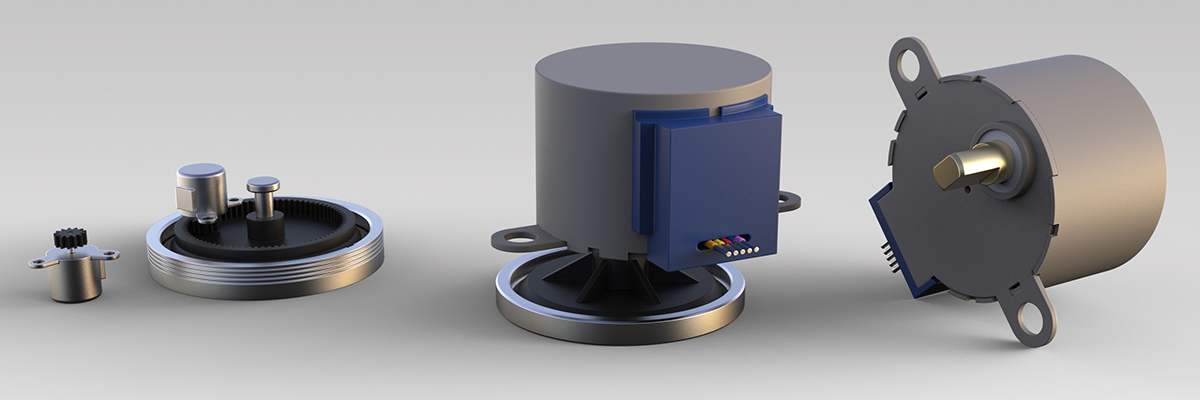
The communicator’s stepper motor (on the left) is tiny compared with the monster that drives the tricorder’s moiré disc.
A stepper motor is needed because small DC motors function at high speed and as a result have to be heavily geared to achieve the low rotational speeds required to replicate the pocket-watch driven moiré motion seen in the communicator. The meshing of many tiny gears is a noisy business. The stepper motor is quieter and has the added benefit of accurate digital control of not just the speed, but also individual rotational steps. This provides another benefit for the tricorder’s function as a cabinet display piece.
In use, without additional mechanical complexity and moiré position sensors, it is not possible to know at which position the moiré has stopped. For the perfect display experience, the ideal situation would be for the moiré pattern to replicate the ‘X’ shape seen in the various images of the hero prop. With the stepper motor’s fine control, we are able to include a mode that will allow the user to manually adjust the rotation of the base disc to get the moiré pattern to look just right.
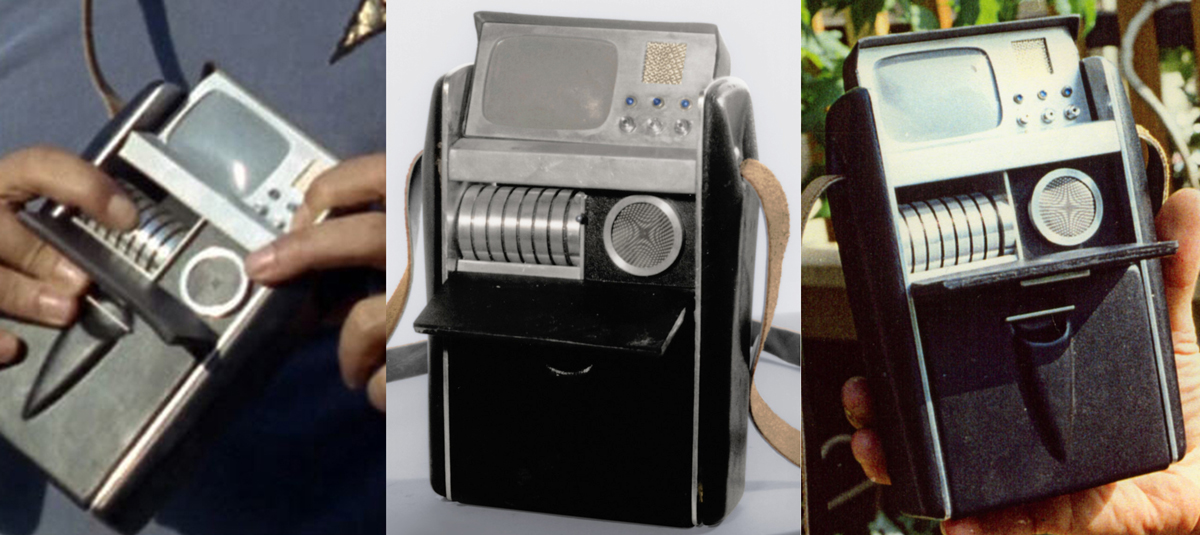
Although the orientation of the moiré’s cross pattern is not constant, the tricorder will have a mode that enables the user to manually adjust the pattern to replicate the pattern seen on images of the tricorder where the moiré is showing, for display purposes.
The further we pushed into the design of this hero prop, the more we got to realise the scientific thinking that underpinned the design choices Wah Chang made. Beyond expensive watered taffeta that gave these shimmering patterns their name, the moiré’s interference fringes are actually a highly scientific phenomena that have had a huge impact in many areas of technology and exploration. Moiré patterns have taken humans from the discovery that light travels in waves, when in 1801 Thomas Young inferred the wave half of the wave-particle duality by observing interference fringes created as beams of light shone through slits, all the way to the 21st century interferometry used by huge telescope arrays that peer deep into the most distant corners of the universe – further from our home planet than Kirk could have ever dreamed.
When different lines cross, interesting things happen.
LLAP
Chris

Coming next time
Little details – Things that matter to us
Fans who register with us will be the first to read our news and the progress of this exciting Tricorder development and, later, where and when to purchase it. You can catch up with the story so far here on this blog, but if you haven’t already done so, why not register your interest in the Tricorder – you’ll then receive a personalised registration certificate and early access to these updates (before we publish them on our website).


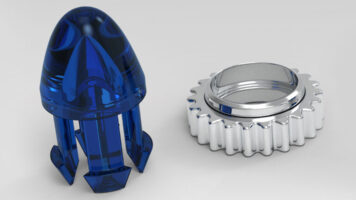
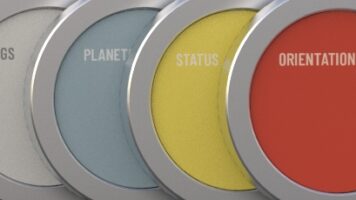
I’m certainly glad that Chang was on the Edmund Scientific mailing list. Who knows what we would have seen in all those aluminum bezels otherwise? Best. Mike.
Just curious, could the Moiré patterns also be faked using an LCD to create readable data? I think the mechanical one is brilliant and more desirable both as art and as a collectible, but a functional one has its own merits.
Funnily enough, we did look into it when we were developing the communicator. Modern displays have very high resolutions. However, I am not sure that they are quite up to the full detail of a small moiré pattern such as the one shown on the comm and tricorder. however… the main issue is the lack of bezel around the edge. Any display needs to be connected somehow, and most round ones have a tail coming out of the edge which needs to be hidden by a bezel of some sort. Those tails are getting smaller and smaller, but even now the most exotic display still requires more space to hide the tail than is afforded by the aluminium bezel that the tricorder has. Also, to get anywhere near the resolution you would need to show a moiré effect realistically, you would need an OLED display and they are rather expensive. Nice thought though; it would be super cool if the moiré could morph into showing other display data.
That may very well become a mod. I’m willing to bet federation credits that there will be some pretty cool mods applied down the road by the very creative and skilled members of the prop community. Chris…TAKE MY MONEY!
In my “head canon”, the moiré display on the communicator and tricorder was a graphic indication of subspace field for transmission/reception that all personnel were trained to interpret. It was fun to learn your thoughts lay along similar lines. The tricorder obviously would have had transceiver capabilities, at least for data, so this always seemed to make practical sense. If this concept had been developed in production of the series, perhaps we would have seen the moiré scanner display on Uhura’s bridge console instead of Spock’s. In an interesting side note, I have read that Spock’s moiré scanner was seldom used when there was dialog because the directors hated how noisy it was.
On a personal note, I was a prop-collecting enthusiast in the ’90s and lost the enthusiasm after realizing I was spending lots of money on inanimate, misshapen lumps of resin or vacuformed kydex. I never acquired a prop that didn’t leave something desired – often a lot desired. The boutique prop makers of the 2000s (we know who I’m talking about) made better products, but I always considered their stuff not worth the asking price.
So, props were nowhere on my radar when I became aware, less than a year ago, of your company and the TOS Communicator you produced. Admittedly late to the party, I grabbed one off Ebay at considerably more than the issue price, and could not be more pleased with my ownership of it. The attention to every detail, and the acknowledgement and respect for the artist that brought it into being, makes ownership even more enjoyable. Your pleasant and friendly dialog with patrons of your business is remarkable and an asset to your business model.
Every kid who was a Trekkie wanted a “real life” Communicator. Now I have one. I am truly looking forward to the Tricorder. Thanks for rekindling a flicker of the wonder and imagination I thought I had lost. LLAP
It’s at least possible that the credit for the moiré usage might properly belong to Matt Jeffries. It was used on the Science Station on the bridge and that would be in the realm of the Production Designer and Art Director, as opposed to a contracted prop builder.
On another note, can you imagine the Starfleet Academy class on interpreting your moiré display? And we think calculus is hard. LOL
It’s great that you had the Herocomm site at the time, I used it’s resources as well when I wanted to built a screen accurate Communicator. Alas, they seem to be gone, speculation is that it was a take down notice, which is hard to understand. They weren’t in it for the money, no ads or anything to sell, just historical information about Star Trek TOS props.
I would like to know the supplier and model number of the communicator’s stepper motor, for a project of my own.
(I would have entered this comment on a communicator-specific page, but I couldn’t find one. Thanks.)
John, the place for this request is the support page, here: https://www.thewandcompany.com/contact-us/. Please use the contact us page (the link can be found at the bottom of all The Wand Company web pages), thanks.